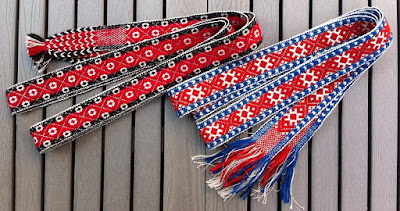The more I explore the elements that make up Estonian culture, the more I appreciate it for its unique qualities. Estonian folk art and traditions are treasured in Estonia which has led to their survival despite foreign occupations and the relentless march of technology. Countless demonstrations, workshops and craft fairs take place in Estonia every year which inspire the next generation to carry on these time-honoured traditions.
Many wonderful examples of Estonian handicrafts can be found in Estonia but if you are looking for them online, it is best to search using Estonian words. The Estonian word for handicraft is 'käsitöö', embroidery 'tikand' and fabric 'kangas'.
The Fabric of the Estonian Nation.
Handwoven belts from Juuru and Viru-Nigula
Estonia is renowned for its beautiful folk art. Embroidery, lace-making, woodwork and knitwear are some of the handicrafts which have been practised with perfection in Estonia for generations.
The blue cornflower (Rukkilill) was made the national flower of Estonia in 1968. It's commonly found in rye fields and is associated with daily bread. The cornflower is one of the national symbols of Estonia and features prominently in Estonia handicrafts.
A lovely Estonian linen apron consisting of lace and cornflower embroidery.
An embroidery design commonly found on women's blouses as part of the national costume.
The designs form Muhu Island are absolutely charming!
The colourful flowers set against the black background is popular with locals and visitors alike.
A traditional Muhu wall hanging.
Beautiful!
Estonian dress fabrics are unique to each parish, not unlike the Scottish tartans which vary according to clan.
Each parish in Estonia has its own unique national folk costume.
The designs vary according to region and, as you can see, its worn with extreme pride!
Fabric from Kadrina Parish.
Manufactured by OÜ Olgitex-rahvuslikud puuvillased triibukangad
Võidu tn 5A(kudumine) Rakvere.
National costume fabrics are not solely used for the national dress. Estonians also enjoy decorating their homes and practical every day items to keep a link to their roots.
Go shopping in your regional style!
Possibilities are endless with the things you can create!
The St. Martin Day Fair is Estonia's largest handicraft and folklore lifestyle event. Held over 4 days in the Saku suurhall in Tallinn, it is a must for all lovers of Estonian folk art. You never know what you might find! http://www.folkart.ee/eng/st-martins-day-fair
To discover more about the wonderful world of Estonian folk art and handicrafts, please click here:
http://www.folkart.ee/ http://www.crafts.ee/














